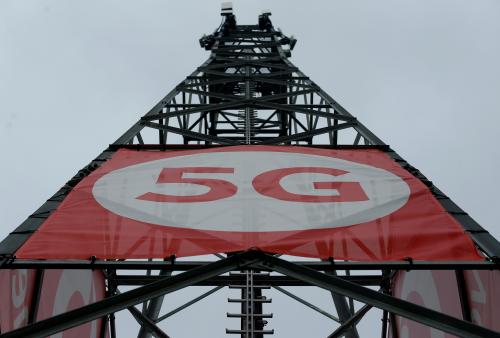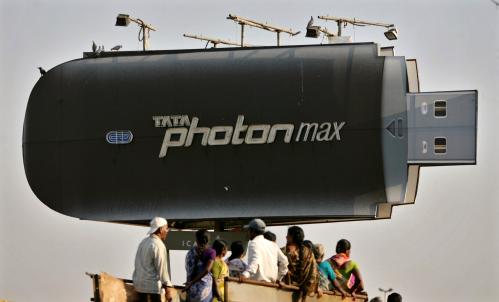Commissioner Brendan Carr of the Federal Communications Commission (FCC) recently spoke at Brookings on why the U.S. needs to ramp up its efforts to deploy fifth-generation, or 5G, networks. With expected peak download speeds as high as 20 gigabits per second, 5G networks can download a full-length high-definition movie in seconds. It also has lower latency and greater connectivity to enable specialized tasks and functions, including remote precision medicine, connected cars, and augmented reality. 5G will also enable better end-to-end machine connections, which will drive the burgeoning economy of the “internet of things” (IoT) and related applications.
However, China and South Korea are poised to outpace the U.S. in 5G deployment, according to a recently commissioned study by CTIA. China, who ranks first in the study’s 5G readiness index, is already eliminating regulatory red tape to expedite deployment and make it easier for industry to access large blocks of higher frequency spectrum bands, which are the airwaves that will enable these next-generation wireless networks. As part of a five-year plan to deploy 5G by 2020, China’s advanced wireless networks are projected to reach 428 million people by 2025, add more than RMB 6.3 trillion into their economy, and create more than eight million jobs. A 5G-ready China will not only be a global leader in product delivery, but also in technical patents, usability testing, and industry certifications.
While the U.S. is rightly no longer considering a similar government-led model, our 5G deployment process is slowed by outdated regulatory processes, spectrum scarcity, and local bureaucracy related to building local towers and other infrastructure. The U.S. faces unique challenges associated with the deployment of small cells, which are antennae the size of a pizza box that enable 5G’s signal strength and resiliency. Deployment delays also result from approval times on small cell applications, permitting, and zoning processes at the local level.
So what will it take for the U.S. to be 5G ready, and why is it important for us to beat global competitors who are on an accelerated schedule to roll out this emerging technology?
The U.S. needs a “5G game plan”
While the U.S. has correctly identified 5G leadership as an important goal, a coordinated, comprehensive, and focused approach by Congress, state and local leaders, and the private sector will be needed. Currently, municipalities, states, industry, and other government agencies in the U.S. lack a comprehensive and synchronized strategy, or what I call a “5G game plan,” that harmonizes the goals of public policies, investments, and the public interest.
While having a common goal should be the foundation of any proposed 5G game plan, the framework for this discussion should also prioritize the following three points.
1. The U.S. must rapidly adopt complementary public policies with timelines that address ongoing spectrum shortage concerns.
Higher frequency spectrum will be the lifeblood for advanced wireless networks. Both the House and Senate have recently introduced the bipartisan AIRWAVES Act to expedite the creation of a pipeline of spectrum for 5G by requiring the FCC and the National Telecommunications and Information Administration to make it available across a variety of frequencies, including low-, mid-, and high-bands. While the current legislation has broad bipartisan appeal, it’s important for Congress to act in a timely way. The AIRWAVES Act complements the recent enactment of the RAYBAUM and MOBILE NOW Acts as part of the 2018 omnibus appropriations bill, which paves the way for future auctions and speeds up 5G infrastructure.
Concurrently, the FCC also has the opportunity to bring much-needed mid-band spectrum to market by adopting rules for the 3.5 gigahertz band that will promote 5G deployments. At its July meeting, the FCC launched a proceeding that has the potential to free up hundreds of megahertz of mid-band spectrum in the 3.7 to 4.2 gigahertz band. The agency is also making available high-band spectrum that will, among other things, help free up more millimeter-wave spectrum bands, improve operability requirements within 24 gigahertz bands, and adopt a sharing framework for terrestrial and fixed satellite services.
While all of these actions can address spectrum scarcity concerns, U.S. policymakers and agencies at all levels need to collaborate to hasten the availability of spectrum for commercial wireless use. They also need to work toward short- and long-term coordinated plans that may render even better and faster results.
2. The deployment of small cell technologies must become a priority to accelerate 5G infrastructure.
It is equally important that local, federal, and industry stakeholders work collaboratively on small cell deployment, which is the technical architecture required at the local level. With more than 89,000 local governments in the U.S., policymakers must strike a balance that harmonizes and expedites processes and approvals, and still provides specific localities, especially tribal lands, the ability to provide guidance on safety and aesthetics.
To this end, policymakers should identify and work on laws and regulations at the municipal, state, and federal levels that effectuate a 5G game plan. Jurisdictions without a plan should employ strategies for advancing wireless networks rather than delay the deployment of next-generation mobile networks for their residents, including updates to the guiderails for state and local siting. As of June 1, 2018, 20 states have enacted legislation modernizing regulations to facilitate small cell deployment, and more should follow suit.
Congress is also taking its own steps to expedite 5G readiness. Last month, Senate Commerce Committee Chairman John Thune (R-SD) and Communications Subcommittee Ranking Member Brian Schatz (D-HI) introduced legislation to speed up small cell deployment called the Streamlining the Rapid Evolution and Modernization of Leading-Edge Infrastructure Necessary to Enhance Small Cell Deployment Act (or STREAMLINE Small Cell Deployment Act). The legislation creates a shot clock between 60 and 90 days for state and local governments to decide on industry applications for small cell installation. If the entity misses the deadline, the application would be automatically approved. The legislation also ensures that localities don’t foot the bill for installation of small cells, and requires reasonable cost-based fees for processing applications. Finally, the bill calls for a GAO study on the important issue of identifying barriers to broadband deployment on tribal lands.
While there are legitimate concerns from municipalities about unfair burdens and deadlines, political dogma should not overtake this issue. If passed, the STREAMLINE Small Cell Deployment Act may go a long way toward finding a balance between local entities, the federal government, and the private sector to avoid burdensome application processes, unfair and disparate fee structures between localities, and difficult compliance requirements for municipalities. Moving forward, these issues require a multi-stakeholder approach where policymakers and practitioners can embrace the ultimate benefits of 5G deployment, particularly those that will accrue social and economic value back to constituents.
3. Stakeholders involved in 5G deployment must keep top of mind the economic and social good that these next-generation networks can deliver.
The final leg of the 5G game plan is to ensure that efforts are ultimately promoting economic and social good. For example, 5G networks can enhance healthcare through the integration of electronic and digital devices (e.g., sensors, smartphones), in upward of $650 billion savings by 2025 provided that faster and more reliable networks enable new technologies, according to a report commissioned by Qualcomm. From medical internet of things devices to online consultations, the capture of real-time medical information and data analytics will empower the healthcare sector, patients, and government to find remedies for skyrocketing costs.
In the healthcare industry and other sectors, 5G can reduce costs for the governments that deploy these networks, the consumers who are in need of additional savings (especially for public interest applications and services), and the enterprises that desire a faster access to the global marketplace.
These three points are not meant to be exhaustive, but a starting point for building a sustainable, competitive, and resilient 5G game plan. The game plan should also include proposals on policies that accelerate fiber availability and regulatory permissions that should go to wireline providers that are also critical to 5G deployment.
But what should be evident is that without a plan that addresses both the priorities of multiple stakeholders as well as the technical requisites of this emerging technology, the U.S. will not be 5G-ready, thereby falling behind our global competitors who seek dominance in the ecology driving the next-generation of wireless networks.
Christoph Mergerson contributed research to this blog post.
CTIA is a donor to the Brookings Institution. The findings, interpretations, and conclusions posted in this piece are solely those of the authors and not influenced by any donation.









Commentary
Will the US be 5G ready?
July 13, 2018